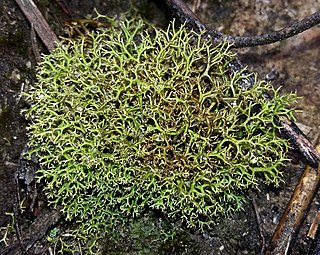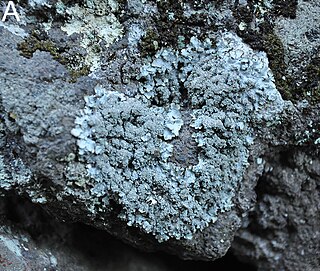
Cladia is a genus of lichenized fungi in the family Cladoniaceae. Cladia species have a crustose primary thallus and a fruticose, secondary thallus, often referred to as pseudopodetium. The type species of the genus, Cladia aggregata, is widely distributed, occurring from South America, South Africa, Australasia and South-East Asia to southern Japan and India. Most of the other species are found in the Southern Hemisphere.

Punctelia is a genus of foliose lichens belonging to the large family Parmeliaceae. The genus, which contains about 50 species, was segregated from genus Parmelia in 1982. Characteristics that define Punctelia include the presence of hook-like to thread-like conidia, simple rhizines, and point-like pseudocyphellae. It is this last feature that is alluded to in the vernacular names speckled shield lichens or speckleback lichens.
Austroparmelina is a genus of foliose lichens in the large family Parmeliaceae. It contains species formerly placed in the genera Parmelina and Canoparmelia. All species of Austroparmelina have an Australasian-South African distribution.
Bulbothrix meizospora is a species of foliose lichen in the family Parmeliaceae. It is found in Africa, Asia, and South America, where it grows on tree bark.

Punctelia guanchica is a species of foliose lichen in the family Parmeliaceae that is only known from the Canary Islands. It is similar in appearance and morphology to the North American Punctelia rudecta, and was historically misidentified as that species until molecular phylogenetic evidence showed it to be a distinct species. It differs in having thicker isidia that develop from the centre of the pseudocyphellae, and it mainly grows on rocks.
Punctelia purpurascens is a species of foliose lichen in the family Parmeliaceae. Found in Brazil, it was formally described as a new species in 2007 by lichenologists Marcelo Marcelli and Luciana da Silva Canêz. The type specimen was collected in the municipality of Vicara in the southern Brazilian state of Rio Grande do Sul. There it was found growing on a basaltic rock in an open field. The specific epithet purpurascens refers to the unusual K+ purple reaction of the medulla.
Punctelia nebulata is a species of foliose lichen in the family Parmeliaceae. Found in Australia, it was formally described as a new species in 1988 by lichenologists John A. Elix and Jen Johnston. The type was collected in New South Wales, on a roadside north of Gilgandra. The lichen grows on Callitris trees in semi-arid, inland regions of southern Australia.
Punctelia imbricata is a species of foliose lichen in the family Parmeliaceae. Found in Brazil, it was described as a new species in 2009 by lichenologists Marcello Marcelli, Patrícia Jungbluth, and John Alan Elix. The holotype was collected in the Paulista municipality of São Paulo State. There it was found growing on the trunk of a mango tree, which was in a shaded and humid location in an orchard. The lichen has a greenish-grey thallus measuring 15–20 cm (6–8 in) wide, with a smooth upper surface that becomes a bit wrinkled in age; the lower surface is black. Punctelia imbricata contains trace amounts of atranorin and lecanoric acid, minor amounts of orcinyl lecanorate, and gyrophoric acid as the major secondary metabolite in the medulla. The specific epithet imbricata refers to the "imbricate" lobules.
Punctelia roseola is a species of foliose lichen in the family Parmeliaceae. Found in Brazil, it was described as a new species in 2009 by lichenologists Patrícia Jungbluth, Marcello Marcelli, and John Alan Elix. The specific epithet refers to the pale rose colour of the medulla. The holotype was collected from Jurumirim municipality in São Paulo State, close to the Tietê River. There it was found growing on an isolated tree in a dry pasture, without direct sunlight. It has a grey thallus measuring 10–20 cm (4–8 in) wide; the lower thallus surface is pale, becoming darker near the centre. The lichen contains atranorin, lecanoric acid, and several butlerins as minor compounds, butlerlin D as a somewhat major compound, and gyrophoric acid as the major secondary metabolite in the medulla.
Punctelia constantimontium is a species of foliose lichen in the family Parmeliaceae. Its range includes South America, Africa, and Mexico, where it grows on bark and twigs.
Punctelia negata is a little-known species of foliose lichen in the family Parmeliaceae. It is found in South America.
Punctelia subalbicans is a species of foliose lichen in the family Parmeliaceae. It is found in Australia and New Zealand, where it grows on the bark of various tree species.
Punctelia colombiana is a species of foliose lichen in the family Parmeliaceae. It is found in South America.
Punctelia subpraesignis is a species of foliose lichen in the family Parmeliaceae. It occurs in Mexico, South America, and East Africa, where it grows on bark and on rocks. Major characteristics of the lichen that distinguish it from other Punctelia species include the C+ and KC+ rose spot tests of the medulla, ascospores that are smaller than 20 μm, and unciform (hooklike) conidia.
Punctelia cedrosensis is a species of foliose lichen in the family Parmeliaceae. It is endemic to Mexico, where it grows on the bark of conifers.

Punctelia punctilla is a species of foliose lichen in the family Parmeliaceae. It is found in Africa, South America, and North America, where it grows on bark and on rocks. The main characteristics that distinguish Punctelia punctilla from other species of Punctelia are the presence of isidia on the thallus surface, a pale brown thallus undersurface, and the presence of lecanoric acid in the medulla.
Punctelia pseudocoralloidea is a species of foliose lichen in the family Parmeliaceae. It is found in Australia, where it grows on bark and on wood.

Punctelia bolliana, the eastern speckled shield lichen, is a species of foliose lichen in the family Parmeliaceae. It is found in North America, with a distribution extending from the Canadian province of Ontario south to the central and northeastern United States and Mexico. It grows on the bark of both deciduous trees and coniferous trees.
Punctelia subflava is a species of foliose lichen in the family Parmeliaceae that occurs in Australia.

Punctelia borreri is a species of foliose lichen in the family Parmeliaceae. It is a common and widely distributed species, occurring in tropical, subtropical, and temperate regions of Africa, Asia, Europe, North America, Oceania, and South America. The lichen typically grows on bark of deciduous trees, and less commonly on rock. Some European countries have reported increases in the geographic range or regional frequency of the lichen in recent decades, attributed alternatively to a reduction of atmospheric sulphur dioxide levels or an increase in temperatures resulting from climate change.




